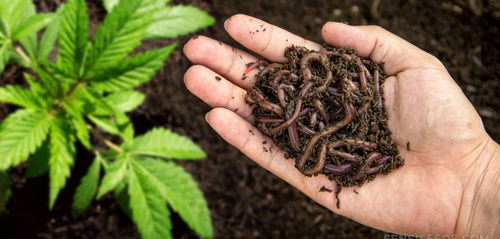#34: The Art of Old-School: Discovering Magi Cannabis
#34: The Art of Old-School: Discovering Magi Cannabis
Salt Spring Island is a gem in the Strait of Georgia, British Columbia, known for its natural beauty, community spirit, and rich agricultural heritage. Amidst this lush and idyllic setting lies Magi Cannabis, a family-owned cannabis farm that embodies the island's values of sustainability, craftsmanship, and community.
Founded by second-generation craft grower Josh Beckett and his wife Nadine, Magi Cannabis has become one of the most beloved and respected cannabis companies on the island and beyond. Drawing on decades of experience in sustainable farming practices, Magi Cannabis grows its own top-shelf cannabis strains to the highest standard with love and care. From selection and cultivation to growing and curing, Magi Cannabis is a truly artisanal experience that emphasizes quality over quantity.
Josh's passion for cannabis cultivation stems from his mother, who's been growing for over fifty years, and who taught him the importance of growing high-quality plants with great care. This same attention to detail is evident in every aspect of Magi Cannabis' operation, from the careful selection and breeding of strains to the meticulous trimming and curing of flowers.
At Magi Cannabis, every step of the process, from seed to harvest to curing, is approached with the utmost care and craftsmanship. They focus on small-batch, artisanal cannabis cultivation of old-school genetics like Pink Kush and Super Lemon Haze, and each strain is grown in small batches with the same intention and dedication.
For Josh and Nadine, Magi Cannabis is more than a business. It's an opportunity to create something meaningful and unique, nurture a community of cannabis enthusiasts, and share their passion for high-quality craft cannabis with the world. With its thoughtful and sustainable approach, Magi Cannabis is leading the way in the craft cannabis movement.
It was a great pleasure to chat with Josh about his journey, his passion for cannabis, and the island ethos that Magi Cannabis embodies. You can check out the full conversation here.
Tell us about your family's roots in cannabis farming and how you came to be in the cannabis industry.
Well, my mom's an aging flower-child hippie. She was always growing and I always really enjoyed the culture when I was growing up. It was something I did for myself personally. And then my grandmother had prescription-resistant Parkinson's and she only responded to cannabis. So we got into the medical program with her in 2009 and I became her designated grower and took on a bunch of clients to support their cannabis needs. Most of them were cancer patients so I became quite involved in early palliative cannabis support, which is pretty fascinating because of how effective it is.

I'll give you an example about cannabis and cancer treatments. A lot of people in early palliative - when I say early palliative, it means that they have a diagnosis of, say three months, and they're not in a hospice. They're living life normally, but with discomfort and so on from their treatment. They might be on chemo and if you support them through diet and alternative pain management like cannabis rather than pharmaceutical painkillers and synthetic opioids, that early part of their palliative care can stretch to two years rather than two months.
This is what I witnessed from a dozen and a half clients that I was a designated grower for that were treating themselves. I'm not saying I was a doctor but I was witnessing how they were supporting themselves on this cancer journey. A person could have two or three years of a relatively normal life before they went into late palliative care, which is a step where the pain of late cancer is so severe that they have to be on pharmaceutical painkillers. That part of their treatment lasts weeks if not days. If people can keep from going into that end-stage for as long as possible, they can enjoy some really meaningful years of life. That became the reason to do this.
A micro grow was such an easy fit because I had been in the medical program so early. I was writing documentation for early start-ups, doing the SOPs (standard operating procedures) and so on. I already had security clearance and so it was an easy fit to go for a micro. But I never had any help and I haven't gotten any grants. There are no grants on the west coast of BC.
There's no support here and every wall is thrown up against you. It’s been a really, really, really hard time. Harder than I could have ever thought. I never thought it was going to be that hard to get a micro going on our own sweat. And I know it's easier now but it's still a micro. This idea that it's just a ma and pa thing that any ma and pa who was doing six lights could just become a micro. It's not a proprietorship. I started as a proprietorship, but it's just too complex. And you need too many people involved. So we're a corporation now.
What makes Saltspring Island such a great place to grow cannabis?
It's actually not a great place, but it is good. And the reason it's good is, for one, Saltspring is a wonderful place to live. It's a safe place to live. The people are great people. They're kind. They're alternative. We're the only spot in the country that has both a federal Green MP and a provincial Green member.

It's got a strong environmental vibe here, but it's mixed with an old-timer fishing logger vibe and they bang up to one another. But the other thing that it has is amazing, beautiful ocean air. People don't really talk about that much but what does the plant take in the most? It takes in the air. That's the biggest input.
We've got real ocean growing here big time and there's a moderating effect on our climate that makes indoor growing a lot easier here. So we have that moderate climate and can keep the rooms cool just naturally. Those are the two things that are really going for the island.
The negatives are that there's no support for us. There's no infrastructure. There are no industrial buildings so I had to build everything myself. The labour pool is very small and there's a lack of housing for middle-class and lower-income people. So it's very hard for a gardener to support themselves.
The national regulations that have been set up and the tax structure around cannabis production is nearly impossible to operate here.
How does the Saltspring Island ethos impact the way you go about running Magi Cannabis?
I love being able to go downtown and I know friendly faces. When you go shopping, you're going to know three or four people in the grocery store. You go down to the beach, you're going to know some people. It's a great size island. There are not enough good things to say about it.
There are 25,000 people here so it's not too big and not too small. There are a ton of creative people - many artists, lots of music, and great boating. It's just a really fun place to live so I think that plays into who we are - artsy hippie, fun-loving, open to all like LGBTQ+. We're a pretty alternative and loving group of people.
What sets your approach to cultivation apart from other cannabis companies in your opinion?
I can't really speak about other cannabis companies, but for a long, long time I have been driven. It's a family business - my son works here, my sister works with me, and all my friends that have been growing for quite a while are here. We’re small on Saltspring. Our land is small. We're on little rocks and stuff, you know?

So it's different, but what I've been doing for a long time, since probably 2009, is and it's gotten better. It's gotten easier since legalization because there's more sharing of information. But I've always been driven by a passion for doing a good job and producing a good product and taking pride in that. That kind of an old-fashioned ethos around the craft, driven by continually wanting every batch that you do to be good, to meet a certain grade, to continue learning and continue being passionate about doing a good job. It's quite simple.
We're on an island so I don't get to see other micro grows as much as I would like to. I don't know what everyone else is doing, but I would imagine that we're a little bit lower-tech than most people because we don't have the power capacity, and I've built everything myself, and I service everything myself because we don't have specialized trades like some might in the city. Our grow is even laughable for how low-fi it is.
So, there are some challenges there, but I'm not really competing against anyone else. We're just trying to grow a good batch that fits with our niche, and our niche is old-school pre-legalization legacy craft. I'm not chasing the newest cookie, right? That's not a value judgment. I'm just saying that's not really what we're doing. That's not what we're about.
Is nostalgia old school a big part of the process that you use when selecting what strains you'll grow?
Yeah, but that's only because that's what I'm drawn to. The smell, the effect and the flavour will give me a sense of whether it's something that I want to work with. We're totally open to trying new things – R&D, breeding and starting seeds - we're doing all of that. But old school as a niche and a feel for our brand is where we're going.
What strains are the most popular with consumers?
I see ourselves as a smaller restaurant. We have three core items on our menu. The Hippie Headbanger is our big, bold, old-fashioned Head Banger. It's a Sour Diesel - really bold, strong, close to 30% and lots of gassy terps with a lot of lemon mixed in.
And then we've got our Salty Pink, which is probably one of the nicest, sweetest, well-rounded Pink Kush strains there are. You could put that up against a lot of other Pinks and I bet you would agree that it's a nice cut.
And then we've got our dessert, our Salt Spring Love Haze, which is a Super Lemon Haze seed that we've had forever.
Those three, and I have some even older ones that I'm going to bring into the menu that I've had for close to 30 years - the Banger, Pink and Love Haze - all of them are over 15 years old. What we'll do is bring in one or two throughout the year and see what the feedback is and maybe bring them on as a regular strain. But those right now are our three core strains.
Do keep us posted on when you release any 30-year-old cultivar.
Well, that'll be the Timmy's shark. We have a very, very limited trial lot coming down in ten days. So that will be available if you guys would like it.
If Mark (from Golden Spruce) wants it, we'll take it.
Ok, yeah.
Onto the growing process itself, you’re using coco coir as one of your main growing mediums. How has that helped you grow the best cannabis possible?
We've used peat, rock wool and lots of other different ingredients but coco coir doesn't hold on to elements as much as peat so it's a better hydroponic medium. Rockwool is also a very good hydroponic medium but it's an industrial waste, whereas peat is a great addition to our vegetable garden and we don't have a ton of soil on Salt Spring. So being able to amend our vegetable gardens with a beautiful mix that we make is great.

We use a coir blend and a proprietary blend that we've worked out over the years that seems to be really great. It addresses a lot of the problems that peat has. We inoculate our soil at the beginning with beneficials and living microbes, then we feed organically for 2 to 3 months, then switch to a hydroponic solution for the last six weeks.
Then the plants get two weeks of reverse osmosis water - straight water, chemically pure water that just takes out everything else to get that really clean burn, which is super important. The whole process is tailored for that final burn.
Speaking of the final burn, you've gotten rave reviews about how well your products are cured. One member on Discord commented that the Salty Pink was cured by Jesus himself. Can you guide us through your curing process?
Well, we have a big cross and we hang all the plants on it. Now that's a joke, but it's sort of like that. I'm actually of the school that you don't f*** around with the plant when you harvest it. Lots of tissue breaks in the plants while they're curing. I don't like chlorophyll bleeding into my finished flowers so I don't pluck.
It's just a whole plant harvest, 10 to 14 days in a cool dry room and then our beautiful trim staff trim it dry by hand into the auto cure bags for another two weeks, and then it's sold in those bags. So it's a relatively straightforward process, but it's slow, and slow and tasty draws out a lot of the flavours, that's for sure.
Have you noticed a difference when you've plucked and when you've used the whole plant harvest technique?
Excessive plucking starts to get into what one would call a wet trim, and it's a pretty big method. That's when you cut the leaves off of the plant. When you harvest and then wet trim, it would be considered a Canopy Growth style where you feed the buds through a trimming machine, wet.
This would characterize the legal weed of 2018. This is how you produce that legal weed, with massive automated buckers on a flatbed truck that separates all the flowers off the stock instantly.
Sounds very industrial. Go on.
On a moving platform into the machine it all gets trimmed and then they put it on cookie sheets and they put it in a drying room for 2 or 3 days with fans, heat and dehumidifiers.
Why does wet trim smell bad? I finally came to the conclusion that you're cutting the plant, you're bruising the plant, and the plant is weeping chlorophyll. It's bleeding all over itself and chlorophyll is kind of nasty when it dries, it ruins the flower.
The less you fool around with the plant after harvest is the way to do it. You just cut the plant down, dry it naturally for two weeks slowly, then trim it dry and throw it in the final bag, and that's it. You just had one person cut it down and one person trim it. Simple old school and it's the best.
What are some exciting new developments that are happening with Magi and what should we keep an eye out for?
Mark just looked at the Pine Tar. You guys might have the exclusive option of listing that. I think you guys are a great partner to get the ball rolling with it. I've also got my oldest, loveliest Timmy Shark that I'd love to get into cans. We've always wanted to have Timmy Shark in the tuna cans and have been talking about that for 20 years.
Let's make it happen.
Yeah, let's make it happen. And we're in the process of expanding. We might be doubling our capacity, and that would give us the opportunity to do a lot more fun stuff.
Finally, what message do you have to share with the people?
I really like the term budtender. I think that's really cool. The budtender tends to the customer and we tend to the bud for the customer. So what do I do? I'm serving the plant, right? I'm a plant server. So that brings in the idea of service. There's an idea of service because I'm serving this plant to people. And so, it's food. You're nourishing people.
It's a great offering to be able to do that. And it's a responsibility you want to offer something. You want to serve something that's good. And the idea is not to be the best grower in the world. That's not the objective. The objective is to serve something consistently. To serve something good and of value to the people who use it.











